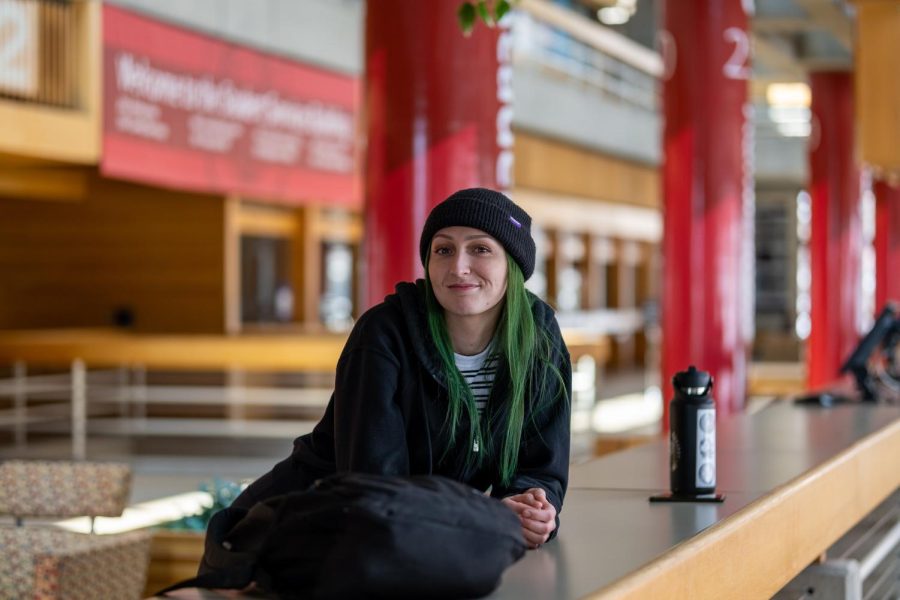U Students Facing Increasing Cost of Living Try To Balance Work And School
Courtney Neilson poses at the University of Utah Student Services Building in Salt Lake City on Thursday, April 6, 2023. (Photo by Marco Lozzi | The Daily Utah Chronicle)
April 10, 2023
As the cost of living in Salt Lake City increases, students working on and off campus are having a harder time balancing work and school schedules.
A 2019 Utah Data Research Center study found that students that work more than 15 hours a week during college see negative impacts on their GPA, retention rates, social life and sleep. The same study found that universities’ curriculum and office hours actively cater to students working “part-time or less.”
Kya Christensen, a third-year film and media student, works as an AV tech support at the University of Utah’s Digital Learning sector. She’s also a resident assistant at the U’s Chapel Glen first-year housing, where she works resolving student disputes in return for housing.
“I work 20 hours at [Digital Learning] and have RA ‘on duty’ shifts every three weeks,” Christensen said.
Along with the occasional resident knocking at her door — sometimes at 3 a.m. — Christensen said she’s had “many sleepless nights grinding to get assignments in” and would love more time to focus on school but is not able to due to financial responsibilities.
“I’m getting $12.75 an hour and that is barely giving me enough to live at the moment with no savings left over,” Christensen said. “$12 an hour just isn’t enough.”
The U currently employs 5,982 students at an average hourly pay rate of $17.75 for undergraduate students and $28.85 for graduate students, said Jeff Herring, Chief Human Resources Officer at the U. There has been a continual increase in students working at the U since 2019, according to HR.
Inflation partnered with the pervasiveness of student loan debt and rising housing prices has made a college degree more of a luxury than a necessity for some.
Courtney Neilson, a fourth-year student studying communications, currently works in healthcare administration for Tang and Company, an occupational therapy clinic. Neilson, 25, left college at 21 for two years while working at the bar and restaurant East Liberty Tap House after not being able to manage a full-time job and college course load.
“I couldn’t keep up with the lifestyle of working at a bar and it was just incompatible with going to school for me,” Neilson said.
Originally from Las Vegas, Nevada, Neilson grew up in what she described as a “working-class blue-collar family.” Neilson attended the U on a debate team scholarship while working full-time and taking college credits, which quickly left her resentful of other students who did not have to work in school.
“I got so jealous and angry over the fact that people got to sit at home and do their homework and get better grades than me while I had to go to work,” she said. “My intelligence wasn’t able to translate into my GPA and that contributed to me dropping out.”
That same 2019 Utah Data Research Report found there is a 12% retention rate difference between working and non-working female students, and a 10% retention rate difference between working and non-working males, all between ages 17-29.
“If you’re working full time, the reason that you’re working full time is because you [have to] support yourself,” Christensen said. “At the end of the day, paying my bills comes first. If I have to pick up an extra shift on a day I have class to make rent, I’ll be picking up the shift. Not because I want to, but because I have to.”
According to MIT’s Living Wage Calculator, the average living wage for an adult in Salt Lake City with no children is $18.06.
Neilson said that working at a bar, instead of on campus, kept her further disconnected from academic culture, which she believed would’ve allowed her to succeed more academically. Students who are employed on campus are more likely to have academic success and internship opportunities.
Looking back as she approaches graduation, Neilson encouraged students to participate in more school clubs, organizations and on-campus jobs.
“That’s a strategy we use at the university, to employ our own [students] and give them that realistic job experience,” Herring said.
In July, Family and Graduate Housing at the West Village plans to reopen its housing. A two-bedroom apartment will go from its original $980 cost to $1,750.
According to the Salt Lake Tribune, the U plans on phasing out more of its affordable housing and accommodating graduate students with stipends, that are yet to be proven sufficient for cost of living, until after July.
“I just think having a more proactive approach towards working students like, ‘We see you,’” Neislon said. “I don’t think that the grading experience needs to treat students as a monolith, it’s not that we’re just slacking off, sometimes there are genuine circumstances that make it impossible to get something turned in.”









